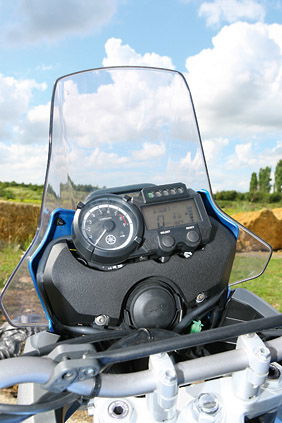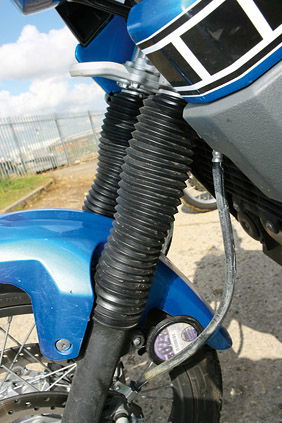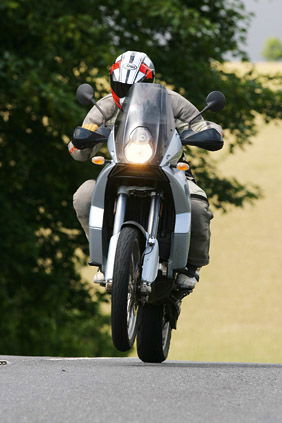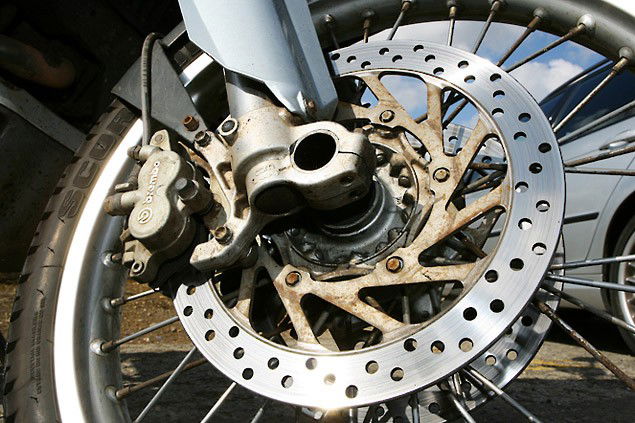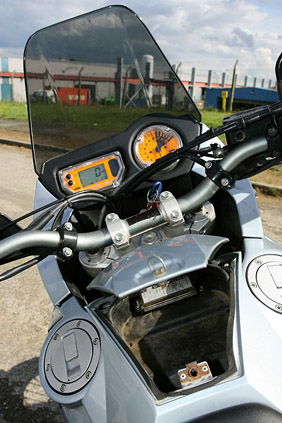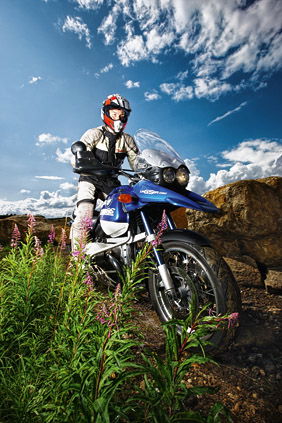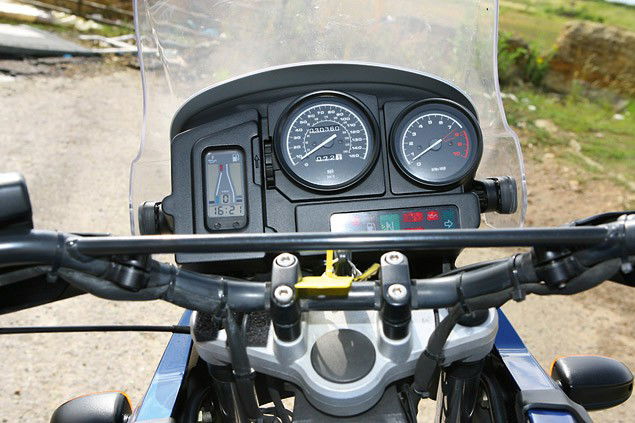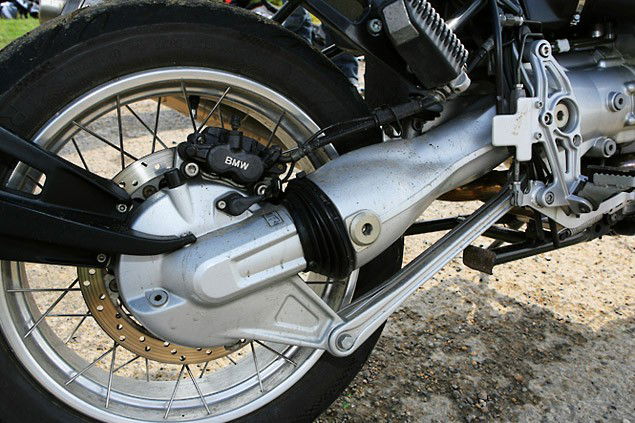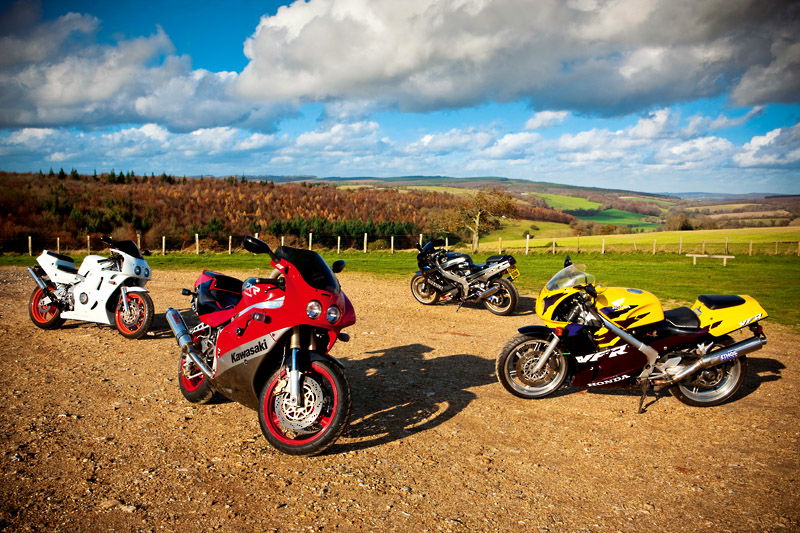Land Rovers: '09 Yamaha XT660Z Ténéré, '03 KTM Adventure, '02 BMW R1150GS
The explosion in popularity of adventure bikes means the used market is now flooded with round-the-world bargains. Escape the rat race for half the price of a GS Adventure...

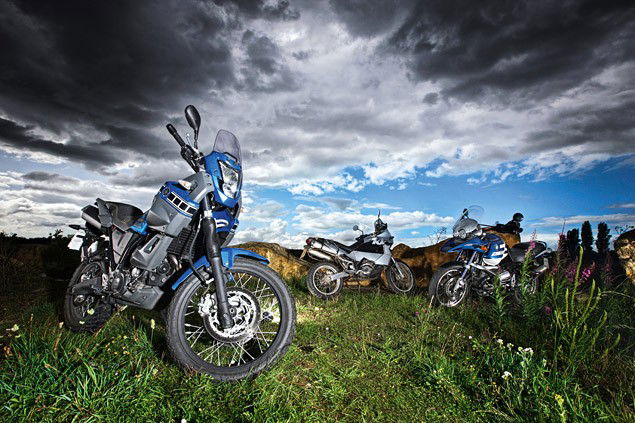
2009 Yamaha XT660Z Ténéré
Japan’s only true world-ready adventure bike. Too focussed?
Click to read: 2009 Yamaha XT660Z Tenere owners reviews
For truly getting away from it all the Tenere, the latest in a long line of capable Yamaha adventure bikes to bear the name, really is a tool. For while many such motorcycles claim to be dual-purpose, selling the overland dream with rugged-looking rubber and the now de rigeur aluminium boxes, the Tenere really is adventure-ready, and certainly the closest Japan’s yet come to a mass-produced overlander.
Based around the same tubular steel cradle frame and liquid-cooled single as the capable but uninspiring XT660R and XT660X, the Tenere adds rally bodywork, a lighter (and prettier) cast aluminium swingarm, a towing eye and a tidy pair of underseat exhausts to create a machine ready for the world’s wildernesses. The chassis, riding position and engine are pure dirt bike and, as a result, the Tenere is head and shoulders above its twin-cylinder opposition on the loose stuff.
The suspension has the travel to cover rough roads at speed or pick its way through the really tough stuff, the engine’s soft, single-bang delivery finds traction where you really don’t expect it to and the fantastic riding position – high and forward over the front wheel – breeds mountains of confidence, as does the generous steering lock. Helping you out no end are the standard issue Michelin Sirac tyres which, on the Tenere, are one of life’s great bike/tyre combinations, up there with Pirelli Supercorsas on a Ducati 998 and Bridgestone’s control slick on Yamaha’s MotoGP M1. Great on tarmac, the Siracs manage to find grip on the most unlikely off-road surfaces too, from Lincolnshire mud to Saharan sand.
Yamaha launched the Tenere in Morocco and, less than four months after trying to ride the same dunes on a BMW R1200GS and a Honda Transalp, the Yamaha was in a different league, ploughing through rutted sand and leaping off ridges like some kind of Dakar racer.
As a bike to ride into the middle of nowhere, the Tenere goes on making sense. At just £4500 secondhand, often with all the accessories you’d want (hard cases, Akrapovic pipes), it’s cheap; cheap enough not to worry about too much and, should you need to, cheap enough to leave behind. It’s also light, so you can pick it up. It’s simple too, with just the one cylinder to worry about. And it’s tough, soaking up spills with nothing more than scuffs to its sacrificial plastic armour. Certainly there are no protruding cylinder heads to put holes in, which can sideline a GS quicker than you can say, “Excuse me Morrocan metalworker, can you weld magnesium?”
So that’s it then, the less-is-more Tenere is the perfect adventure bike. Kinda. Be honest, are you really planning to head off? Because if you’re going to commute or tour on your adventure bike for a few years first, building up to the day you tell the handbrake to get bent, the Yamaha’s worth avoiding. Because great though the Tenere may be as a dual-purpose land rover, as a dedicated road bike it’s not very good at all.
Gutless, soulless, generously packed with vibration and blessed with a ‘powerband’ just 2000rpm wide, the 660cc single is not one of the world’s great engines. A bike that slows down up hills despite a wide open throttle is a novelty you can live without, believe me. The Tenere’s just not fast enough to be able to process A-road traffic like a motorcycle should, the engine forever revving hard and blitzing your pinkies with painful vibration while all the time the turbulent air rolling off the screen buffets your head like an endless stream of mackerel. A great bike then, but only if you’re going to live the dream, not play at it.
Continue for the 2003 KTM Adventure
2009 Yamaha XT660Z Tenere Essential Info
Prices
From £4400 (2008, 3500 miles) to £4950 (2009, 100 miles)
Introduced last year, the current Tenere has been a low-key model for Yamaha UK. Built in low production volumes, the bike is a niche product and the availability of secondhand bikes reflects this, with very few for sale. £4600 buys you an immaculate low-mileage example.
Instant upgrades
- Screen: The Tenere’s standard screen is fantastically poor, generating serious buffeting for any rider, regardless of height. Metal Mule (www.metalmule.com) offer a taller flip screen for £49.
- Luggage: Yamaha’s aluminium side cases are pretty and more affordable than the aftermarket’s at £513 a pair plus £114 for the necessary rack. Yamaha also offer a top case at £263. Inner bags for the panniers are £27 each and £37 for the top case. Metal Mule offer aluminium cases in either an anodised finish for £1175 a pair, including rack, or powder-coated for £1253.
- Armour: Yamaha’s hard parts include a skidplate (£99), engine guards (£99), handguards (£92) and hand deflectors (which sit on top of the handguards for increased wind protection) for £50. Yamaha’s headlight protector costs £52. Metal Mule also offer a headlight cover (£25), a radiator cover (£39), replacement dogbones to lower the bike (£20), heel plates (£22), a rear reservoir protector (£25), a sidestand switch protector (£10) and a chain guard (£68).
- Exhaust: The Yamaha-approved Akrapovic slip-on exhausts cost £513.
Parts costs
While it’d be pretty hard to damage a Tenere’s fuel tank beyond economic repair, if you do the cost of a replacement is a barely believable £1343. A replacement mirror is a much more modest £27 and the panels each side of the tank £28.
Common faults
The fuel injection on the XT engine has come in for some stick but the XT660R and XT660X supermoto tend to suffer with this more, particularly early bikes. Single-cylinder engines tend to be pretty immediate in their throttle response anyway, but the XT lump can jerk badly winding the throttle on in the lower gears.
The generally smoother Tenere runs different mapping to the earlier X and R but take a test ride to make sure you’re happy. Otherwise the only real issue is oil level. The engine’s dry-sumped, holding a portion of its oil in the frame. “To check the level, take the bike for a good fifteen minute ride, let it idle without blipping the throttle and then check the level,” says Tim Brookin of Webbs Yamaha. “People tend to overfill it.”

2003 KTM Adventure
2003 KTM Adventure
KTM’s first twin-cylinder road bike would really rather be off-road. True GS rival or dirt oddity?
Click to read: 2003 KTM 950 Adventure owners reviews
For two machines designed to do pretty much the same thing, it’s hard to believe just how completely different the BMW R1150GS and KTM Adventure are. Where the GS is all about laid-back progress, cosseting its rider with a bubble-bath engine, forgiving spring rates, a seat like a burst sofa and heated grips, the KTM really is a giant dirt bike; instantly responsive engine, barking power, huge suspension travel, a riding position that makes more sense the looser the going gets and a blunt instrument of a seat. Since its launch KTM’s Adventure has been the GS for riders not yet old enough for a BMW, though the German marque’s current reinvention is rapidly shrinking that pool.
KTMs have a very unique DNA and from the off its clear the 950 Adventure is as instantly responsive as any other of the Austrian manufacturer’s machines; they don’t do slack in Mattighofen. Despite the sheer size of both the bike and the front wheel, the 950 Adventure can be flung down a decent road with abandon, flicking from left to right with a jink of the bars, hoarding corner speed with ground clearance you’d have to be insane to fully exploit and a beauty of an engine that makes ramps of every crest – Restraint himself would struggle not to climb aboard a KTM Adventure and ride like a lunatic (see opposite). For despite the 220-mile range, the half-decent weather protection and the easily fitted hard luggage, the 950 Adventure is a hooligan, and perhaps the only bike here you’d ride simply for the sake of it. It really is every bit as fun as a sportsbike on a decent road.
The only significant fly in the ointment is the front brakes’ worrying lack of conviction. Deliberately lacklustre as standard – they comprise a pair of 300mm discs gripped by two-piston calipers; in KTM’s defence sharp brakes are a liability on the dirt – after 18,000 miles and very little by way of doting ownership the brakes on our test bike were borderline dangerous, with little hope of an emergency stop should you want one. Bleed the system at least annually, go OE on the pads and give the calipers a clean and a grease once in a while and the brakes will remain merely adequate.
The 950 is capable on the dirt, proving more effective than the R1150GS, particularly in the hands of less accomplished off-road riders. The bigger front wheel and more generous suspension travel add up to greater speed and confidence on the rough stuff while the more aggressive riding position – the seat and bars push your forward on the bike, more like the Tenere than the BMW GS – helps shimmies and slides feel less like the end of the world and more like a bit of fun. Dirt novices should still think twice before taking to a motocross track, but those with a little experience on the mud will lap up a bit of green lanery.
But there is a price to pay for all this dual-purpose fun, namely comfort. While wind protection isn’t bad, the 950 Adventure’s standard seat is comically brutal and the engine vibrates far more than a GS’s unstressed flat-twin, sending fingers numb within a tankful. Upgrading to KTM’s gel Ergo seat can help but the best advice is to avoid motorways; your sanity and backside deserve more.
Now replaced by the fuel injected 990, the 950 has the sweeter engine and also gives greater range; some 220 miles to dry versus just under 200 on the 990. There’s one final decision to be made. Since its inception KTM has offered an S version of the Adventure with increased suspension travel (and no ABS on the 990 version). If you’re short of leg the lofty S isn’t an option, but regular dirt riders should consider it.
Read about the BMW R1150GS on the next page
2003 KTM Adventure Essential Info
Prices
From £3900 (2002 950 Adventure, 36,000 miles) to £10,900 (2009 990 Adventure, 0 miles)
Expensive new, a cult following keeps Adventure prices keen. Even early high-mileage bikes command £4000, so you need £4500 to go shopping for a clean bike, and preferably a little more. That kind of money buys a 2003 bike with around 20,000 miles on the clock, full service history and hard luggage.
Instant upgrades
Check out the Power Parts range at www.ktm.co.uk to see the huge collection of official accessories for the Adventure.
- Screen: Better than a GS’s for taller riders as standard, but big miles demand a big screen. KTM’s tall screen is £95.
- Exhausts: The Adventure sounds incredible on open pipes. You’ll also get a little more go for your money. Touratech (www.touratech.co.uk) offer Sebring pipes for £797 and Bos silencers for £666. The official Akrapovic exhausts are expensive but lovely.
- Protection: Serious off-roading demands decent protection. Touratech’s stuff is well respected and reasonably priced. They offer a cover for the rear brake master cylinder (£28), frame protectors (£28), a mesh headlight cover (£69), a polycarbonate headlight protector (£38) and a sumpguard (£233).
- Luggage: KTM offer their own plastic cases for £800, which includes three boxes and all the necessary racks. Other options include Zega aluminium boxes through Touratech.
Parts costs
Each of the Adventure’s tanks cost a mighty £900 to replace. A side fairing panel £204 and a mirror £20. Bars to protect the tanks are a good idea.
Common faults
Generally reliable, the 950 Adventure is a simple machine that rarely goes wrong. Finish isn’t the best, especially given the bike’s one of few you might consider riding through winter on. On our test bike the swingarm, front discs and many of the fasteners were badly corroded.
Like the GS, problems arise when routine but detailed servicing tasks are ignored. Go for a bike with full service history for peace of mind. The big twin doesn’t like sitting around getting hot in town. A poorly maintained clutch can suffer and start to drag, making neutral tough to find and causing the bike to creep forward. The front brakes need love to stay on form.
The 950 engine uses carburettors. As a result the throttle response is nicer than the later fuel-injected machines but carb-icing can be a problem. Check your bike has the carb heaters fitted – they more or less cure the issue.

2002 BMW R1150GS
2002 BMW R1150GS
Everyone loves the 1200, but is the 1150 a true alternative or an inferior predecessor?
Click to read: 2002 BMW R1150GS owners reviews
For a keen rider in his early twenties, Visordown part-timer Ian Stewart has a remarkably mature head on his shoulders. After a 30-mile blat on this ultra-clean R1150GS he’s impressed. Left cold by the highly-strung, vibration-addled Yamaha and perplexed by the KTM Adventure (“I just don’t understand why you’d buy one: if you’re going a long way, buy a tourer; if you’re going off-road, buy an off-roader”), Ian’s taken with the big BMW. “It’s the first flat twin I’ve ridden; I didn’t realise they were so smooth,” he says. “It handles well too, turning-in nicely on its Continental road tyres, and it’s just a really enjoyable bike I’d happily ride all day. Any road is comfortable on the BMW and, with a good-sized tank, it could take you a long way. I can see why they’re so popular now.”
And popular they undoubtedly are – in London a GS is now as essential as white wires running into your ears and a latté. But me, I’m not sure about the R1150GS. I ran one for the best part of a year back in 2002, fully expecting some kind of religious experience so enthusiastic was the hype my peers heaped on the big BMW. “Quicker than a sportsbike on tricky roads”, “The new VFR”, “All the motorcycle you’ll ever need” etc.
Unconvinced from the off thanks to the astonishing ugliness of the thing (maybe I’m a little vain but aren’t motorcycles meant to make you feel good, not nauseous?) by the 6000-mile mark I was perplexed. Sure it handled ok, and few bikes on Earth can stop like an R1150GS, but little else made sense. With a rubbish screen it wasn’t particularly comfortable, the engine was flat in the dry and lethal in the wet, where its glut of torque threatened slides on every roundabout and, most disappointing of all, I felt left out. It just wasn’t fun. Maybe a big trip was the answer but I didn’t look forward to riding the thing home, let alone to Tierra del Fuego.
But punting along on this 2002, 30,000-mile R1150GS it’s hard to build a case against the thing. It is immaculate. Arguably it’s a chicken and egg thing – are BMWs really brilliantly finished or do they simply attract owners who look after them? – but it’s hard to believe this bike’s mileage; everywhere the chrome and paint are pristine. Impressive. And it rides well too, less intense than the KTM and, in terms of refinement, comfort and performance, leagues ahead of the Tenere.
There’s no doubt too that the Telelever front end works, lending the bike that familiar and awesome sense of imperious stability, while the wide bars and sensible, road-orientated wheels and tyres (19” front, not 21”, 17” rear and Continental Road Attack tyres) give the GS an edge over the other two bikes changing direction, while also giving the steering a more familiar feel to anyone migrating from a normal bike.
On re-acquaintance the engine’s not bad either, feeling silky-smooth after the single-cylinder Yamaha and raw KTM V-twin. The BMW always feels underpowered though, its not insignificant weight (BMW claimed a whopping 228kg dry) too much for its modest power output (78bhp-ish as standard). On the road the bike feels capable rather than quick. It may only have been a 50cc increase but, with its power boost and hugely significant weight reduction, the GS as a concept really did come of age with the R1200GS.
So the R1200GS is better, as is the R1150GS Adventure, if only for the improved shift action of the enduro gearbox. But if you’ve got £4500 to spend that’s irrelevant. And while £4500 may seem like a lot of money for a seven-year-old, 30,000-mile bike, the GS is undoubtedly a quality product and an impressively versatile one at that. But while everyone loves the R1200GS, the 1150 really is marmite. Try before you buy.
Which used bike is the most adventurous, find out in the Verdict
2002 BMW R1150GS Essential Info
Prices
From £3200 (2001, 50,000 miles) to £7000 (2006 R1150GS Adventure, 200 miles, fully loaded)
GS prices are as firm as sun-baked cow dung and a whole lot more attractive compared to the frightening price of a new R1200GS (£9300). You need £3000 to start shopping and £4500 for a tidy bike with service history and some nice bits. The Adventure boasts an optional bigger tank, a better screen, long-travel suspension, trick wheels and an optional enduro gearbox with a lower first gear and a better shift action. Prices start at just over £5000 and run to well over £6500.
Instant upgrades
Where to start. Here’s but a smattering of the stuff available for the R1150GS.
- Screen: A source of much frustration, the standard screen can be replaced by any number of aftermarket items. Rallye aficionados can opt for Touratech’s Desierto fairing (www.touratech.co.uk), which replaces the GS’s upper fairing with a lightweight fairing, a sculpted screen and some trick projector headlights (£756). Otherwise check out Ermax (www.ermaxuk.co.uk) or Skidmarx (www.skidmarx.co.uk).
- Luggage: Touratech offer a Zega aluminium pannier kit in various sizes (from £713.48) and a raft of racks and soft bags.
- Exhaust: £270 buys you a connecting pipe to eliminate the front silencer. Link that up with one of any number of pipes from the likes of Remus, Bos or Sebring for £350.
- Miscellaneous: Lighting kits are popular (Touratech stock auxiliary foglights at £140 and a Xenon unit that replaces the original headlight for £435), as are hard parts to beef up the GS for off-road falls (steering stop hard parts set, £81; complete hard parts set, which reinforces the gearbox mount on the frame and the footpeg mount, £125).
Parts costs
A replacement R1150GS fuel tank is £700, a mirror £35 and the only real piece of bodywork, the beak that mounts the oil cooler, £250. While replacement parts like these may seem expensive, service items like filters are pretty cheap, like £12 for a genuine air filter.
Common faults
The R1150GS is a notoriously solid machine, despite the failures that were such a part of Long Way Round. When buying, a service history is pretty much essential and a BMW service history better still. Why? Because the only potentially troublesome areas are those that are uniquely BMW. If the oil in the paralever isn’t changed for example, the final drive can fail. Similarly failing to change the brake fluid can be disastrous on an 1150GS with the integral Evo brakes. Condensation gunk ruins the valves in the control unit; £1200.
Check also that the bike you’re buying has had the necessary recall work. Two of these included replacing the seals on the fuel pipe and checking the fuel relay (some bikes left the factory with a relay designed to let them run on low-octane fuel).

Verdict
Verdict
As ever with a test of secondhand bikes, the question is less about which of the bikes here is best and more about which model represents the best used proposition.
While the KTM Adventure on test was in urgent need of some TLC, the fact the bike was still a joy to ride is confirmation of the machine’s fundamental toughness; they’re hard to kill. And there is a decent choice of secondhand Adventures on the market – take the time to seek out a good one. The Tenere enjoys a headstart by virtue of being virtually new. As such it was mint and rode well. That the 30,000-mile BMW did too is impressive and, for its sheer versatility, the blue and white GS has to get the nod of the three bikes we’ve gathered together.
Take condition out of the equation and the test splits into two camps. For true adventurers the Tenere is the winner. This really is a Japanese rival to the much-loved but expensive and highly strung KTM LC4 Adventure. Light, cheap, hugely capable off-road and good fun on it providing the road’s tight enough, the Yamaha is a very likable machine. Handsome too, most people agree. But if you never leave the tarmac the case for the Tenere pretty much collapses, so tight is its focus. Urban riders will appreciate its watchtower riding position, slimness, easy agility and generous steering lock, while those blessed with a residence in the Peak District will enjoy the Tenere’s goat-like ability on steep, narrow and rutted roads but, for everyone else – riders who have to tackle a bit of wide-open, multi-lane blandness – this is a two-horse race; GS versus Adventure.
Despite the long-running debate and forum bickering, choosing between them is pretty straightforward. Do you ride off-road? If so, buy the KTM. It has the chassis, the ergonomics and the snap to relish dirt riding. If you don’t and you need to cover serious miles, buy the GS. Few bikes offer such easy year-round distance ability. The grey area’s in the middle; riders after a fun and capable back-roads machine. Then it’s a case of which virtue floats your boat, the KTM’s raw rider appeal or the GS’s smug refinement?
Specifications
KTM 950 Adventure
Price £4495 Top speed 130mph
Engine 942cc, liquid-cooled, 8-valve V-twin
Bore & stroke 100mm x 60mm Compression ratio 11.5:1
Power 97bhp at 8000rpm Torque 41 lb/ft at 5500rpm
Front suspension 48mm inverted fork, preload, compression and rebound adjustment
Rear suspension Monoshock, preload, compression and rebound adjustment
Front brakes Twin-piston calipers, 300mm discs
Rear brake Single-piston caliper, 240mm disc
Dry weight 198kg (437lbs) Seat height 860mm Fuel capacity 22 litres
Colour options Silver, orange
BMW R1150GS
Price £4500 Top speed 120mph
Engine 1130cc, 8-valve, air-cooled flat twin
Bore & stroke 101mm x 70.5mm Compression ratio 10.3:1
Power 85bhp at 6750rpm Torque 72 lb/ft at 5250rpm
Front suspension Telelever, monoshock, preload adjustment
Rear suspension Paralever, monoshock, preload and rebound adjustment
Front brakes 2 x 320mm discs, 4-piston calipers
Rear brake 276mm disc, single-piston caliper
Dry weight 228kg (503lbs) Seat height 840mm/860mm Fuel capacity 22 litres
Colour options Black, yellow, blue/white, silver
Yamaha XT660Z Tenere
Price £4699 Top speed 110mph
Engine 660cc, 4-valve, liquid-cooled single
Bore & stroke 100mm x 84mm Compression ratio 10:1
Power 46bhp at 6000rpm Torque 43 ft/lb at 5500rpm
Front suspension Telescopic forks, no adjustment
Rear suspension Monoshock, preload adjustment only
Front brakes Twin-piston calipers, 298mm discs,
Rear brake Single-piston caliper, 245mm disc
Dry weight 183kg (403lbs) Seat height 895mm Fuel capacity 23 litres
Colour options Blue/yellow, khaki, red/white, red

